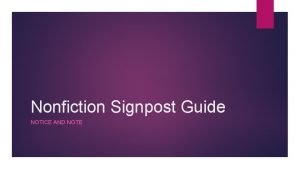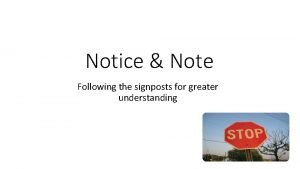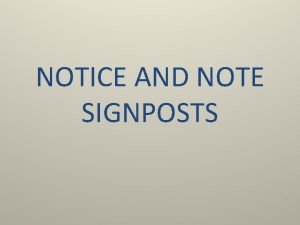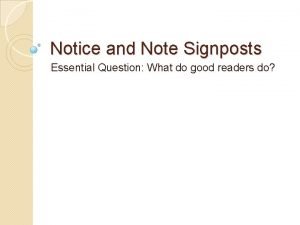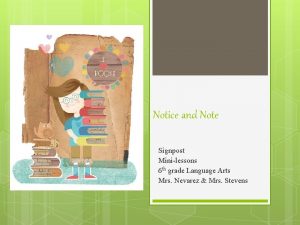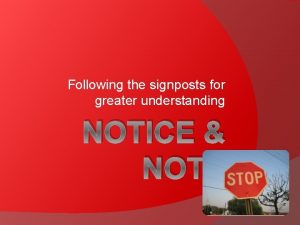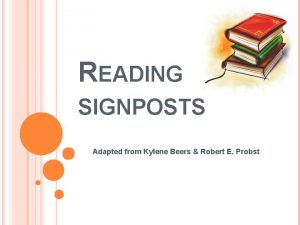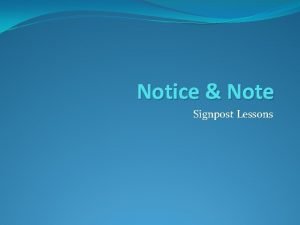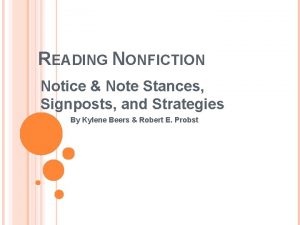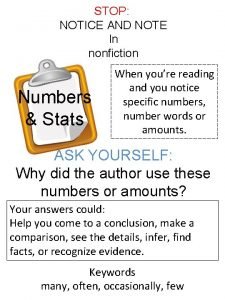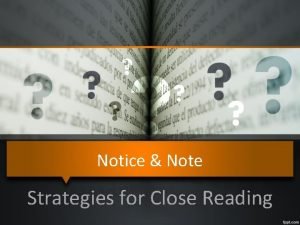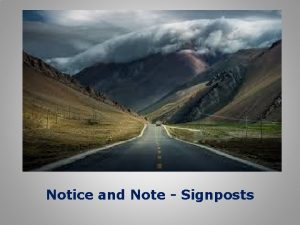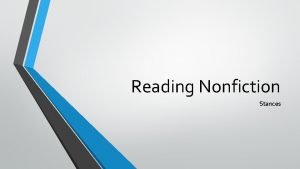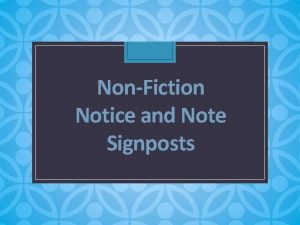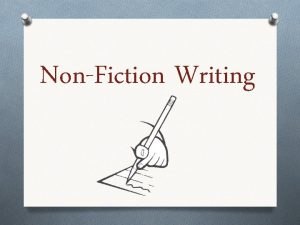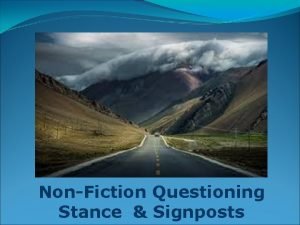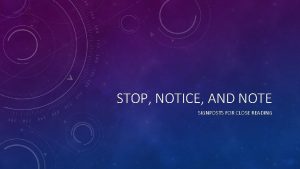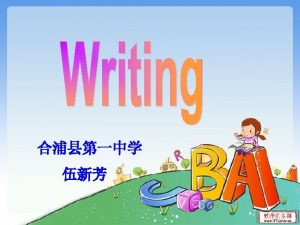READING NONFICTION Notice Note Stances Signposts and Strategies










- Slides: 10

READING NONFICTION Notice & Note Stances, Signposts, and Strategies By Kylene Beers & Robert E. Probst

“We want kids as readers of nonfiction to be active, to challenge the text, and to invite the text to challenge and change them. When students recognize that nonfiction ought to challenge us, slow us down, and make us think, then they’re more likely to become close readers. ” – Kylene Beers and Robert E. Probst 3 BIG QUESTIONS that develop the stance needed for attentive reading 5 SIGNPOSTS that help readers analyze and evaluate the author’s craft 7 STRATEGIES that develop relevance and fix up confusions.

• What did the author think you already knew? • What changed, challenged, or confirmed what you already knew? • Contrasts and Contradictions • Extreme or Absolute Language • Numbers & Stats • Quoted Words • Word Gaps Use These Fix-Up Strategies • What surprised you? Notice & Note These Signposts Adopt a Questioning Stance To Develop Understanding • Possible Sentences • KWL 2. 0 • Somebody Wanted But So • Syntax Surgery • Sketch to Stretch • Genre Reformulation • Poster

Big Question 2 What did the author think I already knew? knew • I DID NOT KNOW… • I WAS CONFUSED BY… • THE AUTHOR ASSUMED… • THE AUTHOR THOUGHT I KNEW…

FOUR TYPES OF PROBLEMS “The author thought I’d know what this word means” (vocabulary) “The author thought I could picture this. ” (visualizing) “The author thought I’d know something about this. ” (Prior Knowledge) “The author thought I’d get how this happens. ” (Sequencing or causal relationships)

HOW DO WE CLEAR UP THE CONFUSION? If the problem is vocabulary, then you might need to look up the word or phrase if the author doesn’t define it in context. If the problem is visualizing, maybe you need to use the strategy called Sketch to Stretch. If the problem is prior knowledge, you might have to research another text to fill in some background knowledge. If the problem is sequencing or causal relationships, you might need to focus on signal words or try Syntax Surgery.

WE TRY IT: The air flows through a channel in the pedestal up to the tube, which is hollow. The interior of the tube acts like a ramp. Air flows along the ramp, which curves around and ends in slits in the back of the fan. Then, the air flows along the surface of the inside of the tube and out toward the front of the fan. Unknown vocabulary? Diffuse Can you visualize it? Sketch to Stretch

YOU TRY IT: WHAT DID THE AUTHOR THINKI ALREADY KNEW? Now you give it a try. Let’s look at this article about a young boy who found an important dinosaur fossil. As you read, when you notice yourself getting confused, circle the confusing part and ask yourself, “What does the author think I already know? ” Jot your thoughts in the margin. You have 10 minutes. Dinosaur Article-Newsela When you are finished, take 10 minutes to share findings with a shoulder partner. If you want, you can create a bubble map to showcase you and your partners findings. Take 10 minutes to share with class.

REFLECTION TIME How does reading with this question in mind clear up confusion as you read? Reflect on this in your journal. Share out.

TEACHER RESOURCES Notice and Note Resources
